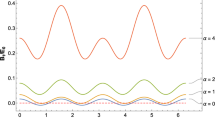Abstract
We study the majority rule transformation applied to the Gibbs measure for the 2D Ising model at the critical point. The aim is to show that the renormalized Hamiltonian is well defined in the sense that the renormalized measure is Gibbsian. We analyze the validity of Dobrushin-Shlosman uniqueness (DSU) finite-size condition for the “constrained models” corresponding to different configurations of the “image” system. It is known that DSU implies, in our 2D case, complete analyticity from which, as recently shown by Haller and Kennedy. Gibbsianness follows. We introduce a Monte Carlo algorithm to compute an upper bound to Vasserstein distance (appearing in DSU) between finite-volume Gibbs measures with different boundary conditions. We get strong numerical evidence that indeed the DSU condition is verified for a large enough volumeV for all constrained models.
Similar content being viewed by others
References
G. Benfatto, E. Marinari, and E. Olivieri, Some numerical results on the block spin transformation for the 2D Ising model at the critical point,J. Stat. Phys. 78:731–757 (1995).
C. Cammarota, The large block spin interaction.Nuovo Cimento 96B:1–16 (1986).
M. Cassandro and G. Gallavotti, The Lavoisier law and the critical point,Nuovo Cimento 25B:691 (1975).
R. L. Dobrushin, Prescribing a system of random variables by conditional distributions,Theory Prob. Appl. 15:453–486 (1970).
R. L. Dobrushin, Lecture given at the workshop, Probability and Physics, Renkum, Holland (1995).
R. L. Dobrushin and S. Shlosman, Constructive criterion for the uniqueness of Gibbs fields, (Birkhauser, Boston, 1985), pp. 347–370.
R. L. Dobrushin and S. Shlosman, Completely analytical Gibbs fields, (Birkhauser, Boston, 1985), pp. 371–403.
R. L. Dobrushin and S. Shlosman, Completely analytical interactions constructive description.J. Stat. Phys. 46:983–1014 (1987).
A. C. D. van Enter, III-defined block-spin transformations at arbitrarily high temperatures,J. Stat. Phys. 83:761–765 (1996).
A. C. D. van Enter, On the possible failure of the Gibbs property for measures on lattice systems, preprint (1996).
A. C. D. van Enter, R. Fernández, and R. Kotecký, Pathological behavior of renormalization group maps at high field and above the transition temperature,J. Stat. Phys. 79:969–992 (1995).
A. C. D. van Enter, R. Fernández, and A. D. Sokal, Regularity properties and pathologies of position-space renormalization-group transformations: Scope and limitations of Gibbsian theory,J. Stat. Phys. 72:879–1167 (1994).
R. Fernández and C. Pfister, Non quasi-local projections of Gibbs states, preprint (1994).
R. B. Griffiths and P. A. Pearce, Mathematical properties of position-space renormalization group transformations,J. Stat. Phys. 20:499–545 (1979).
K. Haller and T. Kennedy, Absence of renormalization group pathologies near the critical temperature—Two examples, University of Arizona preprint, Austin Archives 95–505 (1995).
R. B. Israel, Banach algebras and Kadanoff transformations, inRandom Fields, Vol. II, pp. 593–608, J. Fritz, J. L. Lebowitz, and D. Szasz, eds. (North-Holland, Amsterdam, 1981).
H. de Jong and Ch. Maes, Extended application of high noise constructive criteria for ergodicity of interacting particle systems,Int. J. Mod. Phys. C 7:1–18 (1996).
T. Kennedy, A fixed point equation for the high temperature phase of discrete lattice spin systems.J. Stat. Phys. 59:195 (1990).
T. Kennedy, Some rigorous results on majority rule renormalization group transformations near the critical point,J. Stat. Phys. 72:15 (1993).
T. Kennedy, Private communication.
O. K. Kozlov: Gibbs description of a system of random variables,Probl. Inform. Transmission 10:258–265 (1974).
T. M. Liggett,Interacting Particle Systems (Springer-Verlag, New York, 1985).
J. Lorinczi, and K. Vande Velde, A note on the projection of Gibbs measures,J. Stat. Phys. 77:881–887 (1994).
Ch. Maes, Private communication.
Ch. Maes, Coupling interacting particle systems,Rev. Math. Phys. 5:457–475 (1995).
F. Martinelli and E. Olivieri, Finite volume mixing conditions for lattice spin systems and exponential approach to equilibrium of Glauber dynamics, inProceedings of 1992 Les Houches Conference on Cellular Automata and Cooperative Systems, N. Boccara, E. Goles, S. Martinez, and P. Picco, eds. (Kluwer, Dordrecht, 1993).
F. Martinelli and E. Olivieri, Approach to equilibrium of Glauber dynamics in the one phase region I. The attractive case,Commun. Math. Phys. 161:447–486 (1994).
F. Martinelli and E. Olivieri, Approach to equilibrium of Glauber dynamics in the one phase region II. The general case,Commun. Math. Phys. 161:487–514 (1994).
F. Martinelli and E. Olivieri, Some remarks on pathologies of renormalization group transformations for the Ising model,J. Stat. Phys. 72:1169–1177 (1994).
F. Martinelli and E. Olivieri, Instability of renormalization group pathologies under decimation,J. Stat. Phys. 79:25–42 (1995).
F. Martinelli, E. Olivieri, and R. Schonmann, For 2-D lattice spin systems weak mixing implies strong mixing,Commun. Math. Phys. 165:33–47 (1994).
Th. Niemeijer and M. J. van Leeuwen, Renormalization theory for Ising-like spin systems. inPhase Transitions and Critical Phenomena, Vol. 6, C. Domb and M. S. Green, eds. (Academic Press, New York, 1976).
E. Olivieri, On a cluster expansion for lattice spin systems: A finite Size condition for the convergence.J. Stat. Phys. 50:1179–1200 (1988).
E. Olivieri and P. Picco, Cluster expansion for D-dimensional lattice systems and finite volume factorization properties.J. Stat. Phys. 59:221–256 (1990).
R. H. Schonmann, Projections of Gibbs measures may be non-Gibbsian,Commun. Math. Phys. 124:1–7 (1989).
S. Shlosman, Uniqueness and half-space non-uniqueness of Gibbs states in Czech models.Theor. Math. Phys. 66:284–293 (1986).
W. G. Sullivan, Potentials for almost Markovian random fields,Commun. Math. Phys. 33:61–74 (1973).
Author information
Authors and Affiliations
Rights and permissions
About this article
Cite this article
Cirillo, E.N.M., Olivieri, E. Renormalization group at criticality and complete analyticity of constrained models: A numerical study. J Stat Phys 86, 1117–1151 (1997). https://doi.org/10.1007/BF02183617
Received:
Accepted:
Issue Date:
DOI: https://doi.org/10.1007/BF02183617




